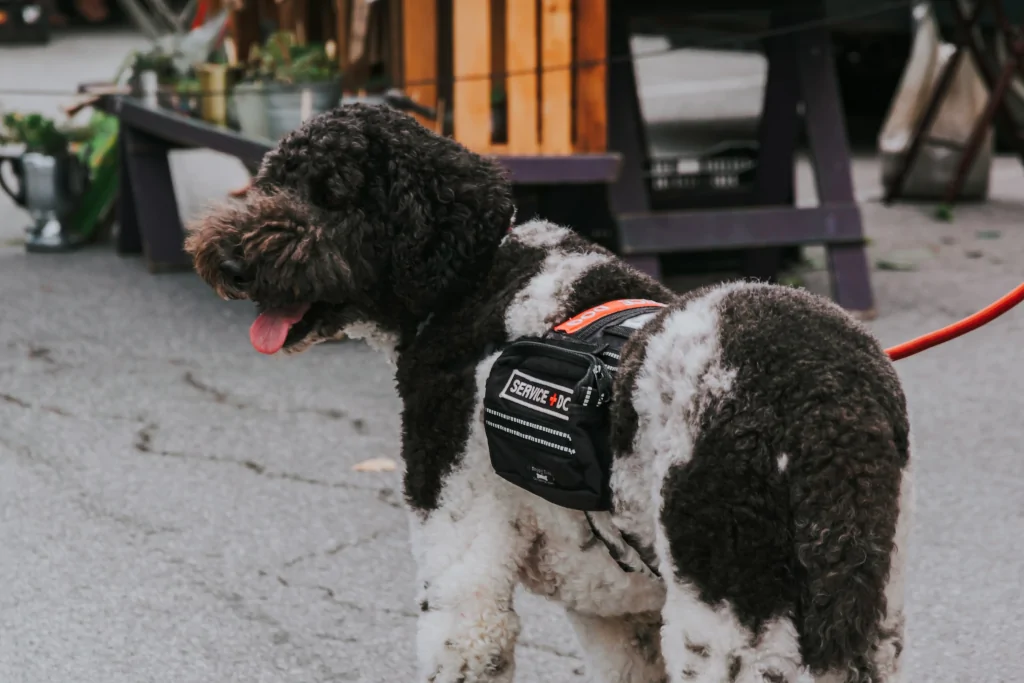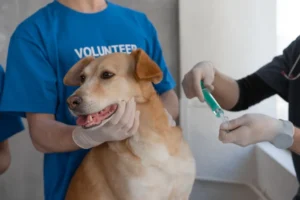Service dogs are incredible companions that transform lives, but what happens when these hardworking heroes want to have puppies of their own? It’s a question that plagues many service dog handlers.
In this blog post, we’ll explore the ins and outs of service dog pregnancies, the impact on their duties, and the role of service dog organizations in the breeding process.
So, let’s dive into the wonderful world of service dog puppies!

Is It Possible for Service Dogs to Have Puppies?
Absolutely! Service dogs, like any other dog, are biologically capable of having puppies. However, there are various factors to consider before allowing your service dog to breed.
The key is to strike a balance between the dog’s working responsibilities and their reproductive health. Service dog handlers must weigh the pros and cons of breeding their service dog.
It’s essential to consider their genetic traits, overall health, and the potential impact of pregnancy on their ability to perform their duties. If you’re a service dog handler, remember this decision should be made in consultation with your service dog’s organization and a veterinarian.
As we delve deeper into this topic, you’ll discover the complexities of raising service dog puppies and the alternatives available during their reproductive years.
The Impact of Pregnancy on a Service Dog’s Duties
Physical Changes
During pregnancy, a service dog will undergo various physical changes, such as weight gain, reduced mobility, and hormonal fluctuations. These changes can impact their ability to perform certain tasks, like providing mobility support or navigating crowded spaces.
Handlers may need to adjust their expectations and be mindful of their dog’s limitations during this time.
Behavioral Changes
Pregnant service dogs may exhibit behavioral changes due to hormonal shifts, such as increased fatigue or reduced focus.
These changes can temporarily affect their ability to respond to commands or complete tasks. It’s important to be patient and understanding, as these changes are a natural part of the pregnancy process.
Vet Visits and Prenatal Care
A pregnant service dog will require regular vet visits and prenatal care, which may temporarily disrupt their working schedule. Service dog handlers must coordinate with their veterinarian to provide the best care for their dog and minimize the impact on their duties.
Maternity Leave
After giving birth, a service dog will need time to recover and care for her puppies.
This “maternity leave” can last anywhere from 8 to 12 weeks. During this time, service dogs may be unable to perform their usual tasks, so it’s essential to plan for alternative support or temporary assistance if needed.
Gradual Return to Work
Once the service dog has recovered from pregnancy and her puppies are weaned, she may be able to gradually return to her duties. It’s crucial to work closely with a professional trainer or the service dog organization to ensure a smooth transition back to work.
In summary, while pregnancy can impact a service dog’s duties, proper planning and care can help minimize disruptions. Service dog handlers must be prepared to make adjustments to accommodate their dog’s changing needs, and always consult with a veterinarian and professional trainer for guidance.
How Service Dog Organizations Handle Breeding
Selective Breeding Programs
Many service dog organizations have established breeding programs to ensure the highest quality dogs for their specific roles.
These programs carefully select dogs with desirable traits such as temperament, intelligence, and physical attributes. The goal is to produce offspring that are more likely to become successful service dogs.
It’s important to note that when a service dog is involved in a breeding program, there might be periods where they are unavailable to assist their handler due to pregnancy, whelping, and caring for puppies. Handlers should be prepared for this possibility and plan accordingly.
Health Screenings and Genetic Testing
Service dog organizations prioritize the health of their breeding dogs and puppies. They perform comprehensive health screenings and genetic testing to minimize the risk of hereditary diseases or health issues that could affect the dog’s ability to perform their duties.
Collaboration with Other Organizations
Service dog organizations often collaborate with other similar organizations to exchange breeding stock or share resources. This collaboration promotes genetic diversity within the service dog population and helps maintain a high standard of dogs for various types of assistance roles.
Breeding and Puppy Raising Volunteers
Many service dog organizations rely on a network of dedicated volunteers who assist with breeding and puppy raising.
These volunteers provide a loving and nurturing environment for pregnant service dogs and their puppies, ensuring that they receive the best care possible during their early development.
Early Socialization and Training
Service dog organizations understand the importance of early socialization and training for their puppies.
Puppies are typically introduced to a variety of environments, people, and other animals to promote adaptability and confidence. This early exposure helps lay the foundation for their future success as service dogs.
In conclusion, service dog organizations have developed comprehensive strategies to manage breeding programs, ensuring that the dogs they produce are healthy, well-adjusted, and suited for their future roles. By focusing on quality and responsible breeding practices, these organizations contribute to the ongoing success of service dogs in assisting those in need.
Alternatives for Service Dogs During Their Reproductive Years
If your service dog is approaching their reproductive years and you’re considering their future, one option is to arrange a temporary replacement during their maternity leave.
Many organizations can help you find a suitable interim service dog to provide assistance while your dog focuses on raising her puppies.
For example, I once had to find a temporary service dog for a friend while her service dog took maternity leave. Charlie was a well-trained and eager Labrador Retriever who seamlessly filled in, providing much-needed support during that period.
Another option is to consult with your service dog organization and a veterinarian to discuss spaying or neutering your service dog, especially if they are not part of a selective breeding program. This decision will depend on various factors, such as the dog’s overall health and their specific duties.
Suggested read: Process of Neutering a Dog and Post-Op Care
Finally, some handlers may choose to retire their service dog early, allowing them to focus on raising a litter of puppies or enjoy a well-deserved break from their duties.
In this case, it’s essential to work closely with your service dog organization to ensure a smooth transition to a new service dog, providing both you and your retiring canine companion with the support needed during this change.
If you’re interested in other service dogs, you may want to explore the option of an emotional support dog. Check out our guide on emotional support dogs with process and tips for more information. To learn more about working dogs (and their difference from show dogs) check this guide.
FAQs
Can a service dog be retired to have puppies?
A service dog can be retired to have puppies, but this decision should be made in consultation with the service dog organization and a veterinarian, taking into consideration the dog’s overall health, age, and suitability for breeding.
Are service dogs spayed or neutered?
Service dogs are often spayed or neutered, especially if they are not part of a breeding program. However, the decision depends on various factors, such as the dog’s overall health, the organization’s breeding policies, and their specific duties.
How are service dogs chosen for their roles?
Service dogs are chosen for their roles based on their temperament, intelligence, physical attributes, and overall health. They undergo rigorous training and assessments to ensure they are well-suited for the specific tasks they will perform.
How long is the training process for service dogs?
The training process for service dogs typically lasts between 1 to 2 years, depending on the complexity of their tasks and the individual dog’s progress. This training period includes socialization, basic obedience, and specialized task training.
Alex, a passionate animal lover, has experience in training and understanding animal behavior. As a proud pet parent to two dogs and three cats, he founded AnimalReport.net to share insights from animal experts and expand his knowledge of the animal kingdom.









